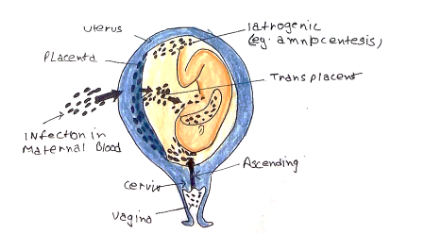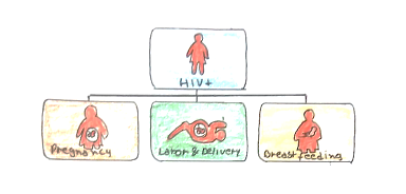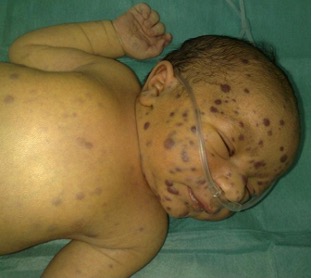There are several infections that can be transmitted from the mother to the fetus. This can be dangerous as the fetus does not have a fully developed immune system and is more susceptible to serious complications.
– Methods of vertical transmission include transplacental (across placenta in utero), during childbirth (due to contact between maternal and foetal body fluids) and breastfeeding.
The pathogens which can be transmitted from mother to fetus can be remembered by acronym TORCH:

Chorioamnionitis
This describes inflammation of the foetal membranes (chorion and amnion) usually due to bacterial infection.
– The major risk factor is preterm premature rupture of membranes exposing the sterile uterus to pathogen
– However, chorioamnionitis can still occur without PROM usually due to an ascending bacterial infection
Causes:
– Usually due to ascending infection from the genital tract (most common)
– Also spread of infection from maternal blood or iatrogenic infection in amniocentesis

Symptoms:
– Infective –> Fever, foul discharge from the vagina, tachycardia
– Uterine –> foul discharge from vagina and uterine tenderness
– Foetal –> May cause foetal tachycardia and distress
Complications:
– Mother –> can lead to postpartum infection and sepsis
– Baby –> Stillbirth, prematurity, neonatal sepsis and brain injury
Management:
– Urgent delivery of the fetus (with C-section) + IV antibiotics
HIV
Human Immunodeficiency Virus (HIV) invades CD4 T cells and gives progressive depletion.
– Pregnant women with HIV need to be treated in order to reduce the risk of transmission to the fetus
– Mothers with HIV should be advised not to breastfeed

Transmission:
– HIV can be transmitted across the placenta, during delivery and also during breastfeeding.
Screening:
– All pregnant women are screened for HIV at the booking tests
– If they are detected positive, they should be offered antiretroviral therapy
Management:
This depends on the maternal viral load at the time of delivery (36 weeks)
If <50/ml:
–> Continue with normal vaginal delivery as very low risk of transmission to fetus
–> After delivery give oral zidovudine to the fetus for 4-6 weeks
If >50/ml:
–> Elective C-section with a zidovudine infusion started before the operation
–> After delivery, treat baby with triple antiretroviral therapy for around 4-6 weeks
Group B streptococcus (GBS)
This bacterium, known as Streptococcus Agalactiae, is the most common cause of neonatal sepsis
– Ut is a commensal bacterium which is found in the vagina or rectum of a significant proportion of women
– Infants may be exposed to maternal GBS during labour and develop potentially serious infections
– GBS is not routinely screened for in the UK, only high-risk women are tested for GBS
Transmission:
During delivery
Symptoms:
Mother:
– It colonises the rectum/vagina usually giving no symptoms, but can spread to other organs
– UTI –> frequency, urgency, dysuria
– Chorioamnionitis –> fever, tachycardia, uterine tenderness, foul discharge
– Endometritis –> fever, lower abdominal pain, IMB, foul discharge (occurs postpartum)
Neonate:
– Gives signs of sepsis (fever, floppiness, respiratory distress, cyanosis, hypotension)
Diagnosis:
– Vaginal/rectal swab and culture
Management
– Give IV antibiotic prophylaxis (IAP) with benzylpenicillin during labour in some situations:
– If previous infant born with GBS disease
– If preterm labour
– If known GBS carrier in current pregnancy
– If mother has fever during labour
If the mother has GBS bacteriuria in current pregnancy, you can offer antibiotics if proven GBS UTI and IAP
– If she is having a caesarean section (regardless of GBS carrier status) then IAP is not required
Cytomegalovirus
This is a herpesvirus, which is the most common virus transmitted to fetus during pregnancy
– About half of people are exposed to CMV virus, but it usually only causes disease in immunocompromised
– However, if pregnant, there is a risk of transmission to the fetus especially in the 1st trimester
– Infected cells have characteristic “Owl’s eye” appearance due to intranuclear inclusion bodies
Transmission:
Transplacental
Symptoms:
It is usually asymptomatic in immunocompetent individuals, but can cause certain symptoms:
– CMV mononucleosis –> flu-like illness with fever, splenomegaly, hepatitis
– CMV retinitis –> visual impairment common in HIV patients with low CD4 count
– CMV encephalitis –> Fever + Headache + Vomiting + Confused/Drowsy + neurological symptoms
Congenital symptoms:
Present at birth:
– Intrauterine growth restriction, microcephaly
– Thrombocytopaenia purpura (“blueberry muffin” lesions)
– Jaundice and hepatosplenomegaly
Later onset symptoms:
– Sensorineural hearing loss and visual impairment
– Psychomotor developmental delay and learning difficulties

Investigations:
– Mother –> check for CMV serology
– Fetus –> Diagnosed prenatally by amniocentesis and PCR
Management:
This depends on whether the mother is immunocompetent or not:
– If mother is immunocompetent:
–> No treatment required (as the antivirals can also be teratogenic)
– If mother is immunocompromised
–> requires specialist treatment (may required termination of pregnancy)
– Foetal congenital CMV
–> IV ganciclovir and oral valganciclovir (+ monitor for complications)
Varicella Zoster (Chickenpox)
This is a herpes virus which causes the condition chickenpox.
– It can infect a pregnant woman causing a primary infection of chickenpox (very serious) which can lead to foetal varicella syndrome.
– Many women have previous exposure to the virus from childhood and so have built up immunity to it.
– The problem occurs when mothers have no previous exposure as this can lead to congenital infection
Transmission:
Transplacental

Symptoms
– Prodrome of high temperature
– Pruritic vesicular rash on head and torso before spreading
– Can lead to secondary bacterial infection of lesions (especially with NSAID use)
Complications:
Mother:
– Increased risk of pneumonitis, hepatitis, encephalitis
Fetus:
– It can lead to foetal varicella syndrome (if infected in first 28 weeks), caused by subsequent reactivation of the virus in utero as herpes zoster
– Skin problems –> scarring in a dermatomal distribution, hypopigmentation
– Eye defects –> optic atrophy, cataracts, optic cup, microphthalmia
– Body defects –> Limb hypoplasia, anal and bladder dysfunction
– Neurological defects –> microcephaly, damage to cervical and lumbar spinal cord
Investigations:
– Check maternal blood for immunity status against VZV
– Check IgM and IgG to VZV –> if positive, indicates immunity against the virus
Management:
i) If the mother has suspected exposure, the first thing to do is check immunity status:
– If mother has immunity –> no further action needed
– If no immunity –> give varicella zoster immunoglobulin (VZIG) within 10 days of contact
– If she is >20 weeks pregnant you can offer acyclovir (antiviral therapy) instead of VZIG
ii) If mother has confirmed chickenpox:
– Give acyclovir
– Serial US examinations at 5 weeks post infection to check for any foetal abnormalities.
Toxoplasmosis
This is an infection due to the parasite toxoplasma gondii, found in cats
– Cat acquires infection by eating cysts in infected tissue
– These then grow and release trophozoites and form tissue cysts
– Release gametes which form oocysts released in faeces
– Faeces eaten by rats and birds which then eaten by cats again

The problem is that humans acquire oocysts via GI tract (infected animals, and water) or through breaks in the skin
– The trophozoites spread to organs and make tissue cysts
– However, in pregnant women, they can cross placenta to enter fetus
Transmission:
Transplacental
Symptoms:
Most infections are asymptomatic
Mother:
– Usually resembles infectious mononucleosis –> fever, lymphadenopathy, fatigue
– Meningoencephalitis –> seen in HIV, giving meningitis symptoms of fever, headache and pain
Fetus:
– Can give encephalitis and calcifications of the cerebral hemispheres
– Also affects the eyes (necrotising retinochoroiditis) giving inflammation and cataracts
– Can also give nasal malformations (rarer)
Hepatitis B
The hepatitis B virus usually causes an acute infection in adults. However, in children, it is more common for the virus to persist causing a chronic infection leading to serious liver damage later on.
Transmission:
Spread during delivery through blood and body fluids (NOT in breastfeeding)
Symptoms:
Mother:
– Acute jaundice (mixed conjugated and unconjugated bilirubin) with dark urine
– Fever, tender hepatomegaly, nausea, weight loss and elevated LFTs (ALT>AST)
– May progress to chronic infection, liver cirrhosis and hepatocellular carcinoma
Fetus:
– More likely to cause chronic hepatitis infection
– Leads to early onset liver cirrhosis and hepatocellular carcinoma
– Can cause polyarteritis nodosa and glomerulonephritis
Management:
Mother:
– All pregnant women are screened for Hepatitis B at their booking test
– If acute or chronic infection, offer treatment
Fetus:
– At birth give hepatitis B immunoglobin (HBIG)
– Also give full Hepatitis B vaccination at birth, 4 weeks and 1 year of age
Rubella
This is a viral infection also known as German measles, which is caused by a togavirus
– It is a virus transmitted by aerosol droplets, but now very rare due to the MMR vaccine
– However, if contracted during pregnancy, it can pass to the foetus giving congenital rubella syndrome
There is no screening programme for rubella. If woman is tested and no immunity is shown, then:
– Avoid contact with anyone who may have rubella
– Get the MMR vaccine in the postnatal period (live vaccine so do not give in pregnancy)
Transmission:
Transplacental
Symptoms:
– Often asymptomatic in children
– Prodrome with low grade fever, malaise and headache
– Diffuse, fine maculopapular rash starting on face but spreading to whole body
– Rash lasts about 3 days (hence why it is called 3-day measles)
– Swollen lymph nodes (suboccipital and posterior cervical)
– Joint pains and conjunctivitis

Congenital Rubella symptoms
There is a classic triad:
– Sensorineural deafness
– Eye problems –> congenital cataracts, microphthalmia and glaucoma
– Congenital heart disease –> pulmonary stenosis, Persistent ductus arteriosus
– May also cause skin lesions (blueberry muffin appearance), thrombocytopenia, learning disability etc
Investigations:
– Viral serology –> IgM (seen in acute infection) and IgG (seen after infection or vaccination)
– Parvovirus B19 serology (this is done as very difficult to distinguish between this and rubella)
Management:
Mother:
– Rubella infection is self-limiting, and no treatment is needed
Fetus:
– Risk of transmission to is highest in the 1st trimester, so management depends on gestational age
– If <12 weeks –> High likelihood of defects so reasonable to consider abortion
– If 12-20 weeks –> Requires more investigations to see if has caused foetal abnormalities
– If >20 weeks –> no action required as very low risk of vertical transmission to the fetus

